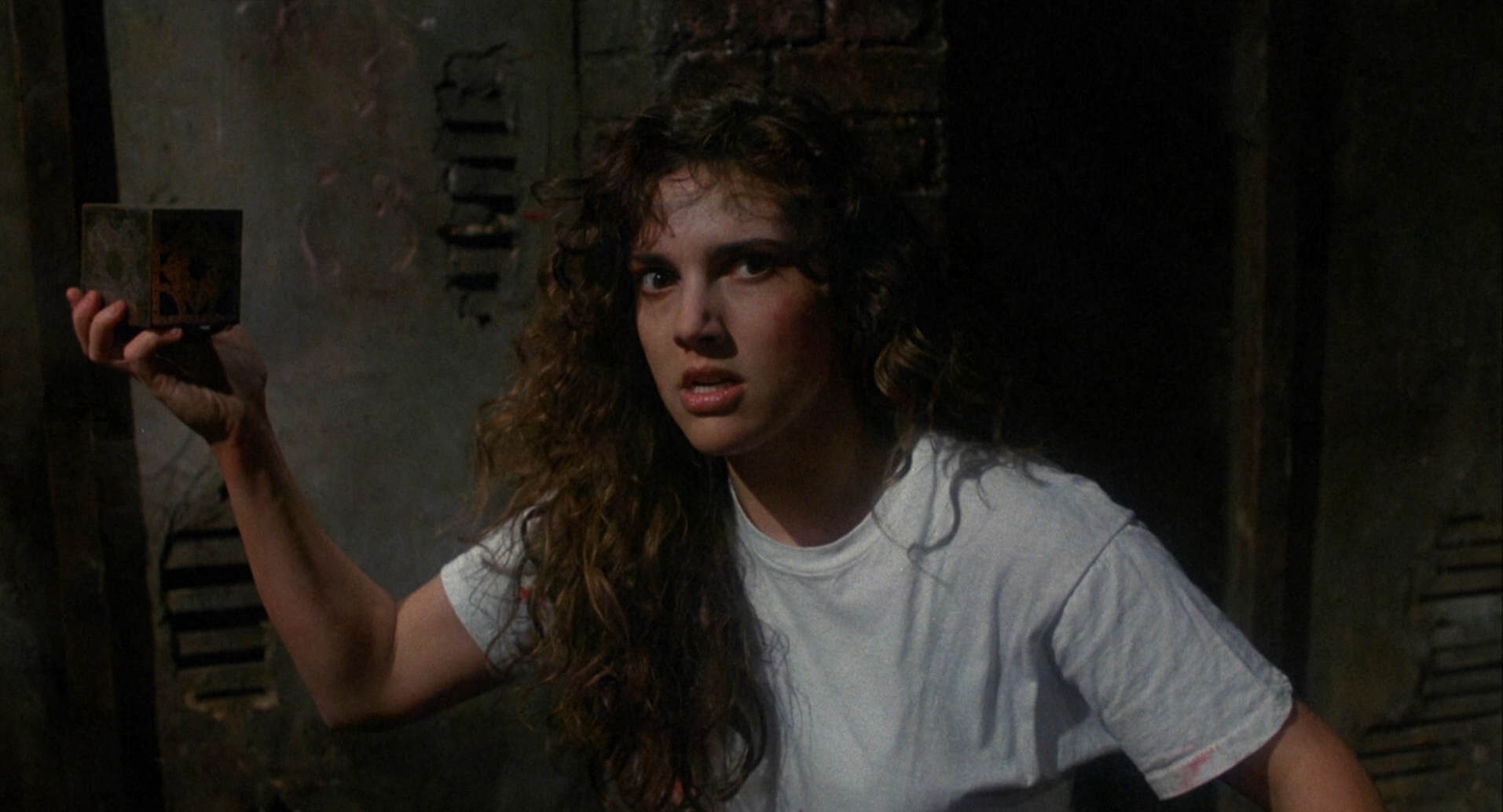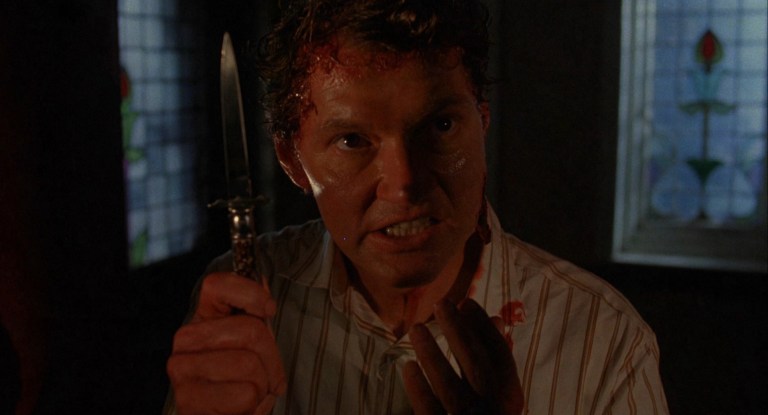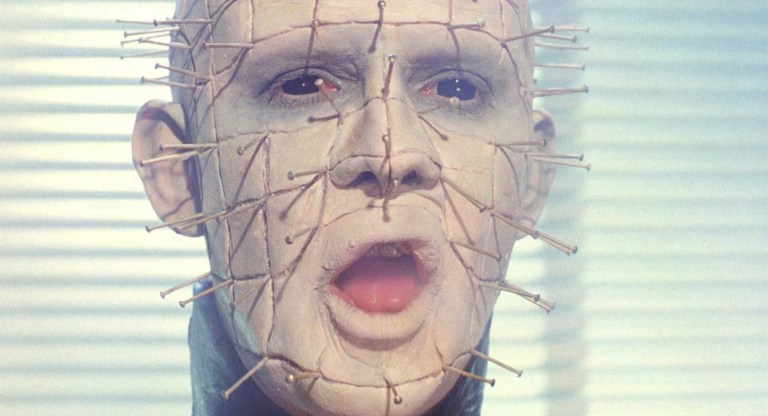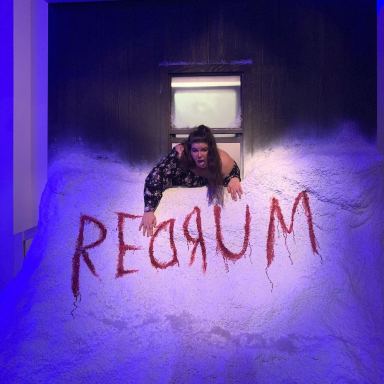28 Little-Known Facts About ‘Hellraiser’ (1987)
Hellraiser by Clive Barker was a runway success at the box office in the 1980s. Here are some little known facts and trivia about the iconic horror movie.

Based on an obscure 1986 novella by Clive Barker, the film Hellraiser so impressed Stephen King that he said, “I have seen the future of horror—and his name is Clive Barker.” Hellraiser was unique for its time because although it was a horror film, it was not a slasher movie, and neither was the main villain a boogeyman.

Hellraiser’s basic plot revolves a family who finds a puzzle box and opens it, unwittingly unleashing hell into their lives in the form of grotesque creatures known as Cenobites, who cannot tell the difference between pleasure and pain. It also involves a demented sexual relationship between a woman named Julia (Clare Higgins), who fetches murder victims to replenish the body of her dead lover, Frank (Sean Chapman).

The film’s original budget was only around $1 million, but it grossed an estimated $20 million in box-office receipts. As of late 2021, the original had led to nine sequels and a couple of remakes that have been perma-stalled in development hell.
Here are 28 unusual facts about the original installment in this classic horror franchise.
Title Changes
1. Since it was based on his novel The Hellbound Heart, that was originally going to be the film’s title. The studio objected, saying it sounded too much like a romance film. Barker then suggested Sadomasochists From Beyond the Grave. The studio rejected that as well. An elderly female crew member suggested What a Woman Will Do for a Good Fuck, which Barker politely shot down before settling on Hellraiser.
2. Hellraiser was released in Croatia as Lords of Hell, in France as The Pact, in India as Son of the Devil, in Mexico as Door to Hell, in Portugal as Cursed Fire, in Serbia as Lords of Hell, and in Taiwan as Raise Ghosts and Eat People.
Clive Barker: Director and Screenwriter
3. Clive Barker had only made two short movies before Hellraiser, which marked his debut as a feature-film director.
4. Clive Barker said he was disappointed with how producers treated his material in the 1985 film Underworld, which led him to write The Hellbound Heart, which would eventually be made into Hellraiser. He said he went to a library to find books about how to direct movies, but both books that dealt with the topic had already been checked out.
5. Barker has stated that he sees Hellraiser as more of a love story than a horror movie. He has said that Julia’s motivation for bringing men back to her house and killing them is done out of a deep devotion to Frank: “She’s not committing murder in the way that Jason in the Friday the 13th films commits murder—just for the sake of blood-letting —she’s doing it for love. So there is a sympathetic quality about her, enhanced hugely in my estimation by the fact that [actress] Clare Higgins does it so well.”

6. Barker says that when he first screened Hellraiser for his mom, she cried joyful tears when she saw his name in the opening credits, at which point he leaned over and whispered that she’d be a lot less happy over the next two hours.
7. Regarding his debut as a director, he said that he remembered the production with “unalloyed fondness…the cast treated my ineptitudes kindly, and the crew were no less forgiving.” He also claimed that he was so inexperienced, he “didn’t know the difference between a 10mm lens and a 35mm lens, if you’d show me a plate of spaghetti and said that was a lens, I might have believed you.”
8. Barker said that he wanted to focus on quality acting rather than gore and teen-horror tropes: “I’m not just taking the 12 most beautiful youths in California and murdering them, I’ve got real actors, real performers—and then I’m murdering them.”
Pinhead the Cenobite

9. Over the course of the Hellraiser series, the breakout villain was Pinhead the Cenobite, originally played by actor Doug Bradley. Ironically, in 1973—14 years before Hellraiser—Bradley had played a character very similar to Pinhead in a play called Hunters in the Snow.
10. In Clive Barker’s novel The Hellbound Heart, the main Cenobite character was Butterball, with Pinhead playing a supporting role.
11. Barker said that the overall stylistic inspiration for the Cenobite designs came from a mix of Catholicism, punk-rock fashion, and his personal visits to S&M clubs in Amsterdam and New York.
12. Barker claims that his inspiration for Pinhead’s look came from African fetish sculptures.
13. The name “Pinhead” is not used in Hellraiser; Bradley’s character is listed in the credits as “Lead Cenobite.”
14. The Pinhead character was named “Priest” in early drafts of the script and then became “Lead Cenobite.” It was the crew who renamed him “Pinhead,” a name that Clive Barker disliked because he found it unsophisticated.
15. Doug Bradley had been offered a choice between the role of Lead Cenobite and a bit part as a mattress-mover. He originally leaned toward the role of mattress-mover because at least the audience would see his face.
16. After a first reading of the script, Bradley said he envisioned Pinhead as a hybrid of Oscar Wilde and Noel Coward.
17. Clive Barker says that since Hellraiser was being filmed during the apex of horror films such as Friday the 13th, Halloween, and A Nightmare on Elm Street, the producers suggested that Pinhead should be a more lighthearted character and occasionally crack jokes. Barker refused and said he wanted Pinhead to be more a more austere character in the vein of Christopher Lee’s portrayals of Dracula: “Part of the chill of Dracula surely lies in the fact that he is very clearly and articulately aware of what he is doing; you feel that this is a penetrating intelligence and I don’t find dumb things terribly scary, I find intelligence scary, particularly twisted intelligence; it’s one of the reasons why Hannibal Lecter is scary, isn’t it? It’s because you always feel that he’s going to be three jumps ahead of you.”
18. Doug Bradley says he envisioned Pinhead as physically and mentally stronger than either Jason Voorhees or Michael Myers.
19. Bradley says that Barker told him to conceive of Pinhead “as a cross between an administrator and a surgeon who’s responsible for running a hospital where there are no wards, only operating theatres as well as being the man who wields the knife, he’s the man who has to keep the timetable going….”
20. Bradley says that during a post-production party, he was disappointed when it seemed like other crew members were ignoring him or even outright shunning him. He later realized that they didn’t even recognize him because they were used to seeing him in the Pinhead makeup.
21. In promotional materials, Bradley dressed up in Pinhead makeup—which, on average, took six hours to apply—was featured all over the place, although his name was not mentioned and no one could see his face. He said, “It was great to be so heavily featured, but there was no way to prove to anyone that it was actually me. Those who were following Hellraiser at the time were wondering where the guy with the pins was! Well I can tell you where I was—I was sitting at home in England, watching it all happen from the sidelines.”
The Soundtrack
22. Barker had originally chosen the industrial band Coil to record the Hellraiser soundtrack. They recorded a soundtrack that Barker said “made my bowels churn.” But the studio found the band’s soundtrack too harsh and instead chose Christopher Young to record an alternate score. Young had already scored horror movies such as 1985’s A Nightmare on Elm Street 2 and 1986’s Invaders From Mars. Coil’s original nine-song soundtrack is a collector’s item on CD.
Much of the Dialogue Was Dubbed

23. As with the novel, the film was set in England, but Roger Corman’s new World Pictures said the film would be more successful if it was set in the USA. Much of the dialogue was dubbed by American actors—all of Sean Chapman’s lines were dubbed by another actor.
Promotion
24. Two of the film’s advertising taglines were “Demon to some, angel to others” and “He’ll tear your soul apart.” The latter was featured on the film’s original poster in an identical font to the same tagline on the poster for Ken Russell’s 1975 rock-opera film Tommy.
Censorship
25. After an initial screening, the MPAA threatened to give Hellraiser an X rating, forcing Barker to make the following cuts:
• Shots were removed from the original hammer murder scene, including a shot of the hammer embedded in the victim’s head.
- One scene in which Julia murders a naked man was re-shot so that the man was semi-clothed.
- Close-ups of Kirsty shoving is hand into Frank’s exposed guts were removed.
- Parts of the scene where Frank is being ripped to pieces by the Cenobite’s hooks were cut.
- A shot where Frank’s head explodes and his brain is blasted all over the room was removed.
26. In a 1987 interview, Barker also said the MPAA objected to some of Hellraiser’s more overtly sexual scenes: “Well, we did have a slight problem with the eroticism. I shot a much hotter flashback sequence than they would allow us to cut in…mine was more explicit and less violent. They wanted to substitute one kind of undertow for another. I had much more explicit sexual encounter between Frank and Julia, but they said no, let’s take out the sodomy and put in the flick knife.”

27. Barker said the MPAA demanded other changes to the sex scene between Julia and Frank: “We did a version of this scene which had some spanking in it and the MPAA was not very appreciative of that. Lord knows where the spanking footage is. Somebody has it somewhere…the MPAA told me I was allowed two consecutive buttock thrusts from Frank, but three is deemed obscene!”
28. Regardless of the MPAA’s objections, over the course of the Hellraiser series, there were 24 nude scenes featuring females as of October 2020.
